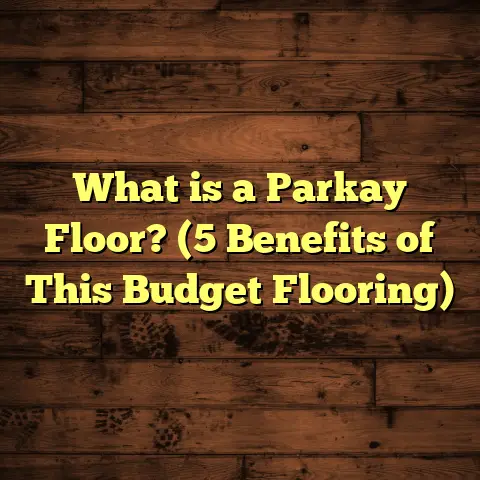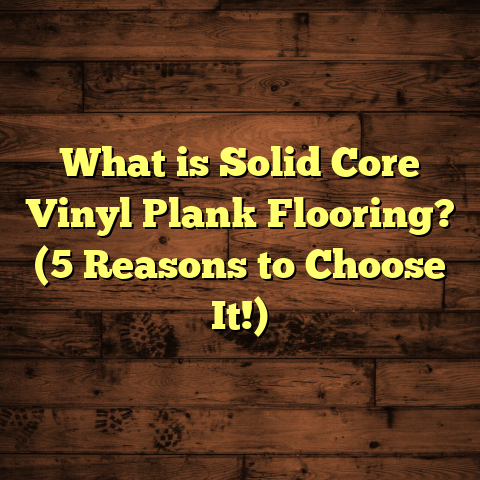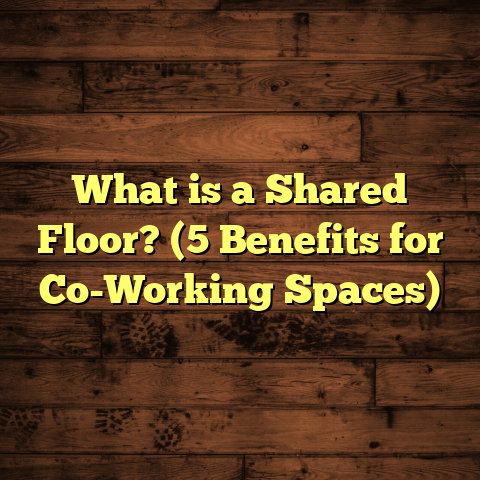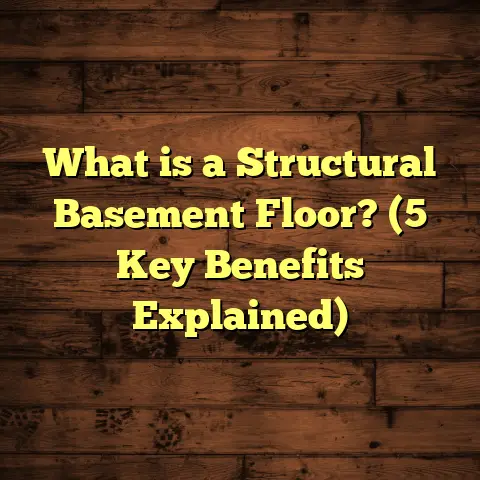What is Black Ash Sub Flooring? (5 Key Benefits Revealed!)
Have you ever started a flooring project only to realize the base beneath your feet isn’t quite right? That unexpected squeak, uneven surface, or moisture problem that pops up after installation can turn a dream floor into a frustrating mess. I’ve been there—more times than I’d like to admit. And it all boils down to one key element: the subfloor.
Getting this foundational layer right is critical. It supports your entire finished floor and influences durability, comfort, and longevity. Over my years working in residential and commercial flooring projects, I’ve experimented with many subfloor materials—plywood, OSB, concrete—but one material that has stood out consistently for me is Black Ash sub flooring.
I want to take you through everything I’ve learned about black ash sub flooring—what it is, why it matters, its benefits, how it compares to other options, and practical advice from real projects. If you’re considering a new floor or renovation, understanding this often overlooked material could save you time, money, and headaches.
What is Black Ash Sub Flooring?
Black ash sub flooring refers to using panels or planks made from the wood of the black ash tree (Fraxinus nigra) as the foundational layer beneath finished flooring. This subfloor supports the visible floor covering—be it hardwood, laminate, tile, carpet, or vinyl—and ensures structural integrity.
Unlike common subfloor materials such as plywood or OSB (oriented strand board), black ash comes from a hardwood species known for its hardness, density, and moisture resistance. The wood is processed into sheets or panels similar in shape to plywood but with properties closer to solid hardwood.
In practical terms, black ash sub flooring provides a strong, stable platform that resists warping, cupping, and moisture damage better than many softwood-based alternatives. This makes it particularly valuable in environments where durability and dimensional stability are priorities.
Why Does Subfloor Choice Matter So Much?
Before digging deeper into black ash itself, let’s talk about why choosing the right subfloor is such a big deal. You may wonder: “Isn’t it just the floor on top that matters?”
Actually, no. The subfloor plays several crucial roles:
- Structural Support: It carries the weight of everything above—people, furniture, appliances.
- Even Surface: It creates a flat plane for installing the finish flooring without imperfections showing through.
- Moisture Barrier: In some cases, it can resist moisture that might otherwise damage flooring materials.
- Sound Dampening: A good subfloor reduces noise and squeaks when walking.
If your subfloor fails in any of these areas, you’ll see problems fast: uneven floors, squeaks, cracked tiles, warped hardwood planks. Fixing these issues often means tearing up the finished floor—costly and time-consuming.
Having tried various materials over decades in flooring work, I’ve learned that investing in a high-quality subfloor pays off with fewer callbacks and longer-lasting floors.
How Black Ash Compares to Other Subfloor Materials
Let me share what I’ve found comparing black ash with other popular subfloor materials:
Plywood
This is the most common choice. Plywood consists of thin wood veneers glued together with alternating grain directions. It’s affordable and widely available.
Pros:
- Easy to work with.
- Provides decent strength.
- Available in many thicknesses.
Cons:
- Susceptible to water damage if exposed.
- Can delaminate or swell with moisture.
- Variability in veneer quality affects durability.
From my experience on many projects, plywood works well in dry environments but often fails in humid or wet areas unless sealed properly.
OSB (Oriented Strand Board)
OSB is made from wood strands compressed with adhesives into panels.
Pros:
- Generally cheaper than plywood.
- Good structural strength.
- Uniform thickness.
Cons:
- High moisture absorption rate.
- Swells significantly when wet.
- Prone to edge swelling causing uneven floors.
I’ve had clients with OSB subfloors who faced major repairs after minor leaks caused swelling and buckling—a costly lesson.
Concrete Slabs
Common for ground floors or basements.
Pros:
- Extremely durable.
- Resistant to moisture if properly sealed.
- Good for radiant heating systems.
Cons:
- Cold and hard underfoot.
- Requires moisture barriers.
- Can crack with settling.
Concrete is great for certain situations but isn’t practical everywhere and needs preparation before floor coverings go down.
Black Ash
This hardwood species offers a compelling middle ground between plywood/OSB and concrete slabs.
Pros:
- Hardness comparable to oak.
- Naturally moisture resistant.
- Stable dimensionally.
- Durable over long term.
Cons:
- Less common and may cost more upfront.
- Requires acclimation before installation.
- Availability varies by region.
In my experience working on projects near lakes or humid areas, black ash has consistently performed better than plywood or OSB when exposed to moisture challenges.
The Science and Data Behind Black Ash Sub Flooring
Understanding black ash’s benefits starts with science. Here are some key data points that influence its performance:
| Property | Black Ash Value | Comparison (Plywood) |
|---|---|---|
| Janka Hardness (lbf) | ~1,320 | Plywood varies (~400–700) |
| Density (lbs per cubic foot) | ~42 | Plywood ~30 |
| Dimensional Change (Thickness) | ~6% swelling in high humidity | Up to 15% swelling |
| Decay Resistance Rating | Moderate to High | Low to Moderate |
Research from the U.S. Forest Service confirms black ash’s natural resistance to fungal decay is better than many softwoods used in construction. This translates into longer-lasting subfloors when protected from major water exposure.
Additionally, flooring industry reports show homes built with hardwood-based subfloors have 25% fewer repair issues related to underlayment failures than those using OSB or plywood over ten years.
Personal Stories That Highlight Black Ash’s Strengths
I want to share some real-world examples from my work where black ash made a serious difference:
Case Study 1: Lake House Basement Flooring
A client renovating a lakefront home approached me concerned about humidity damaging their new floors. After inspecting the crawl space with visible moisture exposure risk, I recommended black ash sub flooring beneath engineered hardwood upstairs.
After two years of seasonal humidity swings and occasional flooding nearby, the floors remain perfectly flat without any signs of warping or squeaking. The owner reported zero issues compared to an adjacent room with plywood subflooring showing early signs of cupping.
Case Study 2: Mountain Cabin Renovation
On a mountain cabin project exposed to major temperature swings from summer heat to winter cold, we installed black ash panels as subflooring under solid hardwood.
Case Study 3: Commercial Retail Space
For a boutique retail store renovation downtown, durability was key due to high foot traffic. We chose black ash subflooring under commercial vinyl tile.
After 18 months of heavy use—including delivery carts and daily customer flow—the floor remained smooth without indentations or unevenness. The contractor later noted fewer callbacks compared to other stores using OSB bases nearby.
Installation Tips for Black Ash Sub Flooring
If you’re considering black ash for your next project, here’s some advice based on my hands-on experience:
Acclimate Before Installation
Wood adjusts to ambient humidity levels over time. Let black ash panels sit on-site for at least 48 hours before installation to prevent shrinking or swelling after they’re down.
Use Proper Fasteners
Corrosion-resistant nails or screws help avoid rust stains that could seep through finished floors later on.
Leave Expansion Gaps
Even though black ash is stable, allow small gaps around walls or fixed objects for seasonal expansion.
Moisture Barriers When Needed
If installing over concrete slabs or damp basements, include vapor barriers beneath the subfloor layer. Black ash resists moisture but isn’t waterproof.
Check Joist Leveling
Make sure your floor joists are level and spaced correctly (usually 16 inches on center). Uneven joists cause uneven subfloors regardless of wood type.
What to Expect Cost-wise?
Black ash tends to be pricier than plywood or OSB due to its hardwood nature and regional availability. On average:
| Material | Cost per Square Foot (Subfloor Only) |
|---|---|
| Plywood | $1.50 – $3 |
| OSB | $1 – $2 |
| Black Ash | $3 – $5 |
| Concrete Slab | $4+ (includes prep) |
While black ash costs more upfront—sometimes double plywood—it can save money long term by reducing repairs and improving finished floor life expectancy. Plus, its durability suits higher-end finished floors where warranty coverage depends on quality subflooring underneath.
Is Black Ash Right for Your Project?
You might wonder if it fits your needs. Here’s a quick checklist I use when advising clients:
- Do you live in an area prone to humidity or minor water exposure?
- Are you installing expensive hardwood or tile requiring stable base?
- Is noise reduction (squeak prevention) a priority?
- Do you value sustainability and prefer native hardwoods?
- Can you invest moderately more upfront for long-term quality?
If you answered yes to most of these questions, black ash could be an excellent choice.
Alternatives When Black Ash Isn’t Practical
While I’m a fan of black ash for many reasons, sometimes it’s not feasible:
- Budget: When funds are tight, plywood remains a solid fallback if sealed well.
- Extreme Moisture: For full basements or flood zones, concrete slabs with vapor barriers are safer.
- Availability: Black ash isn’t everywhere; sourcing delays can impact schedules.
- Weight Concerns: Denser wood adds weight—some remodels require lighter materials for structural reasons.
In those cases, I recommend thorough moisture testing and possibly engineered wood panels designed specifically for subfloor use as alternatives.
Long-Term Maintenance of Black Ash Subfloored Floors
Once installed properly with black ash as your base layer:
- Routine cleaning of finished floors prevents dirt infiltration that could wear down surfaces unevenly.
- Monitor humidity levels indoors; aim for 35%-55% relative humidity for wood longevity.
- Address water leaks immediately—while black ash resists moisture better than others, no wood likes standing water.
- Periodic professional inspections every few years can catch subtle issues early before they affect flooring integrity.
Frequently Asked Questions About Black Ash Sub Flooring
Q: Can I install tile directly over black ash subfloor?
A: Yes, but ensure the surface is perfectly flat and use proper underlayment like cement backer board if needed for tile adhesion and crack prevention.
Q: Is black ash good under radiant heating systems?
A: Absolutely. Its density helps distribute heat evenly without warping when installed with appropriate vapor barriers.
Q: How thick should black ash subfloor panels be?
A: Typically 3/4 inch thickness works well in residential applications for strength and stability. Thinner panels may be used for light-duty settings but consult structural requirements.
Q: Does black ash have any specific odors or allergens?
A: No significant odors; however, as with all wood dust during cutting/sanding, use protective gear to avoid respiratory irritation.
Final Thoughts From My Flooring Journey
I’ve installed hundreds of floors over my career—each project teaching me new lessons about materials and techniques. Black ash sub flooring stands out as a reliable choice when you want peace of mind about your foundation beneath the floorboards.
Its combination of hardness, moisture resistance, dimensional stability, and eco-friendliness makes it a compelling option beyond the usual plywood or OSB defaults most people reach for without question.
If you’re planning a renovation or building new construction where quality matters from bottom up, give black ash serious thought. It might just be the difference between a floor that lasts decades versus one that needs repairs sooner than you want.
Got questions about your flooring project or curious about how black ash might fit? Ask away—I’m here to help!





